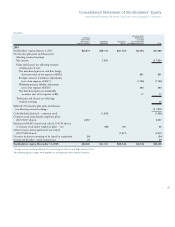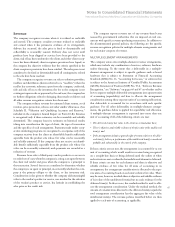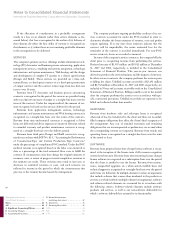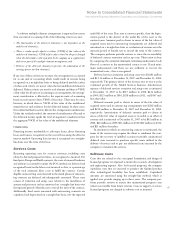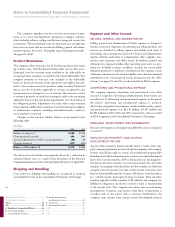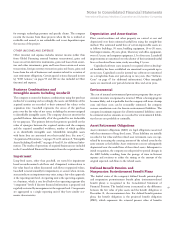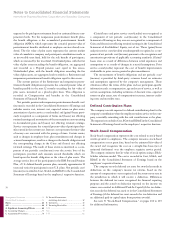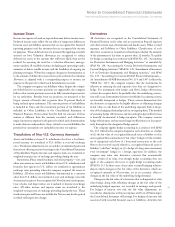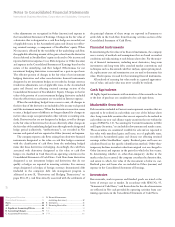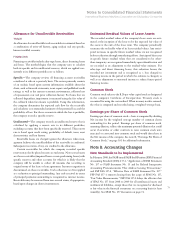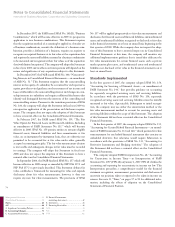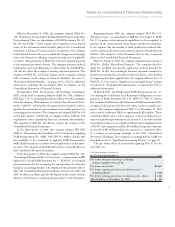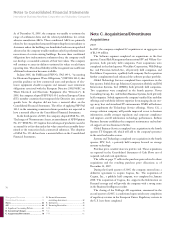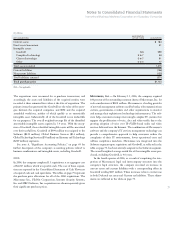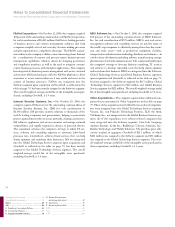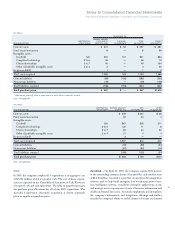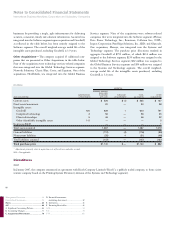IBM 2007 Annual Report Download - page 72
Download and view the complete annual report
Please find page 72 of the 2007 IBM annual report below. You can navigate through the pages in the report by either clicking on the pages listed below, or by using the keyword search tool below to find specific information within the annual report.
70
Notes to Consolidated Financial Statements
International Business Machines Corporation and Subsidiary Companies
Management Discussion ..................................14
Consolidated Statements ..................................58
Notes ........................................................... 64
A-F ............................................................. 64
A. Significant Accounting Policies ............ 64
B. Accounting Changes ...................................73
C. Acquisitions/Divestitures ............................76
D. Financial Instruments
(excluding derivatives).................................82
E. Inventories ...................................................83
F. Financing Receivables .................................83
G-M ..................................................................84
N-S ...................................................................94
T-W ................................................................102
expected to be paid upon retirement based on estimated future com-
pensation levels. For the nonpension postretirement benefit plans,
the benefit obligation is the accumulated postretirement benefit
obligation (APBO), which represents the actuarial present value of
postretirement benefits attributed to employee services already ren-
dered. The fair value of plan assets represents the current market
value of cumulative company and participant contributions made to
an irrevocable trust fund, held for the sole benefit of participants,
which are invested by the trust fund. Overfunded plans, with the fair
value of plan assets exceeding the benefit obligation, are aggregated
and recorded as a Prepaid pension asset equal to this excess.
Underfunded plans, with the benefit obligation exceeding the fair
value of plan assets, are aggregated and recorded as a Retirement and
nonpension postretirement benefit obligation equal to this excess.
The current portion of the Retirement and nonpension postre-
tirement benefit obligations represents the actuarial present value of
benefits payable in the next 12 months exceeding the fair value of
plan assets, measured on a plan-by-plan basis. This obligation is
recorded in Compensation and benefits in the Consolidated
Statement of Financial Position.
Net periodic pension and nonpension postretirement benefit cost/
(income) is recorded in the Consolidated Statement of Earnings and
includes service cost, interest cost, expected return on plan assets,
amortization of prior service costs/(credits) and (gains)/losses previ-
ously recognized as a component of Gains and (losses) not affecting
retained earnings and amortization of the net transition asset remaining
in Accumulated gains and (losses) not affecting retained earnings.
Service cost represents the actuarial present value of participant ben-
efits earned in the current year. Interest cost represents the time value
of money cost associated with the passage of time. Certain events,
such as changes in employee base, plan amendments and changes in
actuarial assumptions, result in a change in the benefit obligation and
the corresponding change in the Gains and (losses) not affecting
retained earnings. The result of these events is amortized as a com-
ponent of net periodic cost/(income) over the service lives of the
participants, provided such amounts exceed thresholds which are
based upon the benefit obligation or the value of plan assets. The
average service lives of the participants in the IBM Personal Pension
Plan, a U.S. defined benefit pension plan, currently approximates 10
years and varies for participants in non-U.S. plans. Net periodic cost/
(income) is recorded in Cost, SG&A and RD&E in the Consolidated
Statement of Earnings based on the employees’ respective function.
(Gains)/losses and prior service costs/(credits) not recognized as
a component of net periodic cost/(income) in the Consolidated
Statement of Earnings as they arise are recognized as a component of
Gains and (losses) not affecting retained earnings in the Consolidated
Statement of Stockholders’ Equity, net of tax. Those (gains)/losses
and prior service costs/(credits) are subsequently recognized as a com-
ponent of net periodic cost/(income) pursuant to the recognition and
amortization provisions of applicable accounting standards. (Gains)/
losses arise as a result of differences between actual experience and
assumptions or as a result of changes in actuarial assumptions. Prior
service costs/(credits) represent the cost of benefit improvements
attributable to prior service granted in plan amendments.
The measurement of benefit obligations and net periodic cost/
(income) is provided by third-party actuaries based on estimates
and assumptions approved by the company’s management. These
valuations reflect the terms of the plans and use participant-specific
information such as compensation, age and years of service, as well as
certain assumptions, including estimates of discount rates, expected
return on plan assets, rate of compensation increases, interest credit-
ing rates and mortality rates.
Defined Contribution Plans
The company records expense for defined contribution plans for the
company’s contribution when the employee renders service to the com-
pany, essentially coinciding with the cash contributions to the plans.
The expense is recorded in Cost, SG&A and RD&E in the Consolidated
Statement of Earnings based on the employees’ respective function.
Stock-Based Compensation
Stock-based compensation represents the cost related to stock-based
awards granted to employees. The company measures stock-based
compensation cost at grant date, based on the estimated fair value of
the award and recognizes the cost on a straight-line basis (net of
estimated forfeitures) over the employee requisite service period.
The company estimates the fair value of stock options using a Black-
Scholes valuation model. The cost is recorded in Cost, SG&A, and
RD&E in the Consolidated Statement of Earnings based on the
employees’ respective function.
The company records deferred tax assets for awards that result in
deductions on the company’s income tax returns, based on the
amount of compensation cost recognized and the statutory tax rate in
the jurisdiction in which it will receive a deduction. Differences
between the deferred tax assets recognized for financial reporting
purposes and the actual tax deduction reported on the income tax
return are recorded in Additional Paid-In Capital (if the tax deduc-
tion exceeds the deferred tax asset) or in the Consolidated Statement
of Earnings (if the deferred tax asset exceeds the tax deduction and
no additional paid-in capital exists from previous awards).
See note T, “Stock-Based Compensation,” on pages 102 to 105
for additional information.



